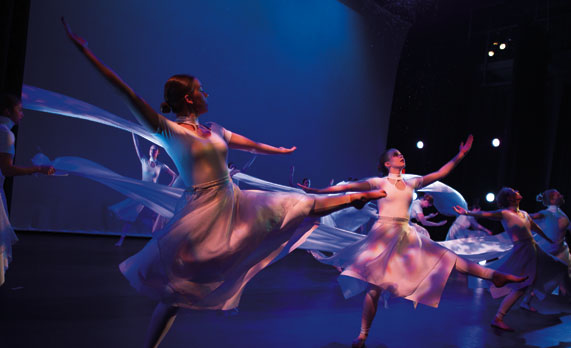
“An Evening with Harvey Dunn’s Feminine Images,†A performance of multi-dimensional, layering the images and words of Dunn with poetry, music, dance, animation and theatrical lighting.
Chances are that Harvey Dunn would give a thumbs-up to a performance that honors his life’s work.
Dunn, who died in 1952 at age 68, is South Dakota’s most famous artist. He grew up on a homestead near Manchester and attended SDSU and the Chicago Institute of Art.
The South Dakota Art Museum is home to 110 of Dunn’s paintings. They are the featured attraction, not only for their artwork, but for the stories they tell — many depicting the legacy of South Dakota homesteaders and the hardships they faced in the rural areas.
A greater appreciation for his work was the idea behind “An Evening with Harvey Dunn’s Feminine Images,†a performance that was held twice in April at SDSU’s Performing Arts Center.
The performances were multidimensional, layering the images and words of Dunn with poetry, music, dance, animation and theatrical lighting.
The production was a collaborative effort through the College of Arts and Sciences. It was created by a group of faculty members working together from the departments of English, theatre, music and visual arts. In addition, more than 50 SDSU students participated as musicians, dancers and actors.
“I think Harvey would love the performance and appreciate using a variety of art forms to tell the story,†says Lynn Verschoor ’79, museum director and one of the collaborators. “This production makes his art come to life and creates multiple access points for the audience.â€
Better insight on Dunn
Four of Dunn paintings were represented in the show: “The Prairie is My Garden,†“After the Blizzard,†“Woman Driving Oxen†and “Fixing Fence.â€
“We wanted to give people a new way to see these important images because they have become so familiar that unfortunately they sometimes are taken for granted,†says English instructor Darla Bielfeldt.
“More importantly, however, is that it captures a portrait of the homesteaders’ experiences and gives insight into the man, Harvey Dunn, and his thoughts on art and life.â€
The paintings were projected on a screen followed by voiced-over poems and music on a soundtrack that correlated to each painting.
“It was great for me and my students to be involved in this project,†says assistant music professor Aaron Ragsdale, who composed the show’s original music.
“I would think that Dunn would be appreciative that his artwork has managed to excite so many people across so many disciplines. I hope he wouldn’t mind taking a little bit of the emphasis from his paintings and spreading it around using other art forms.â€
Bielfeldt wrote the poems and selected some of Dunn’s own quotes on art to incorporate into the show. His quotes like “It’s full of mystery as it should be†and “If you’re going to make an illustration, you must take poetry and song into it†were written down in 1934 by one of his studio art students.
Selections of Dunn’s quotes, as compiled in the book “An Evening in the Classroom,†were recorded by SDSU theater students for use in the performances.
Connects art forms
Animation techniques applied by Cable Hardin, assistant professor in the department of visual arts, brought the paintings to life. In “The Prairie is My Garden,†clouds appeared to be moving, and light snow continually fell in “After the Blizzard.â€
During the music and poetry soundtracks, choreographed dances depicted parts of the paintings. In “The Prairie is My Garden†the dancers stretched out their arms to resemble the mother holding scissors away from her body. And their dance costumes were designed with images of prairie grass.
“For my students it was the experience of learning about themselves through different art forms,†says dance choreographer Melissa Hauschild-Mork, instructor in the department of communication studies and theatre.
“This project helps them to see that those connections between the language we speak as dancers is really no different than the language of other artists. They recognize that art is really just an expression of life.â€
Hauschild-Mork emphasizes that enhancing a master’s work was the collaborative nature of the project.
“It was really about trying to capture the essence of what he was saying in a way that keeps his work alive,†she says. “It was looking at his work from a context when they were originally painted to modern times — and the context is the same — we’re still dealing with the same issues of feeling fear, anxiety and living through blizzards.â€
“An Evening with Dunn’s Feminine Images†was a prelude to a larger work that is scheduled to be finished by spring 2015. Eight more Dunn paintings will be featured with the intention of taking the presentation on the road to other universities so they will have a road map for creating their own artistic collaborations.
“We want to show how we collaborated and worked across disciplines to create a new art form,†says Bielfeldt. “We’re looking forward to taking our show on the road.â€
Kyle Johnson






